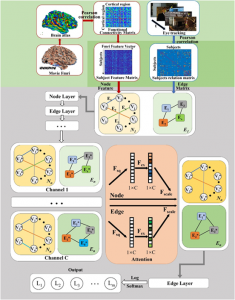Breakthrough Model Utilizes Movie-watching fMRI and Eye-tracking to Predict Cognitive Scores
FAYETTEVILLE, GA, USA, September 6, 2023/EINPresswire.com/ -- Traditionally, functional connectivity in the brain during movie-watching has been challenging to use for accurate predictions, especially with limited datasets. With the rise of portable and cost-effective eye-tracking devices, researchers saw an opportunity to supplement mfMRI data to observe subconscious behaviors of participants. However, creating a unified framework to integrate this information effectively remained elusive.
In a recent article published in Volume 3 of the journal Psychoradiology, researchers from Northwestern Polytechnical University have unveiled the groundbreaking "Attention-CensNet" (A-CensNet), a fusion model that predicts cognitive scores by amalgamating movie-watching functional magnetic resonance imaging (mfMRI) and eye-tracking data. In this model, participants serve as nodes, mfMRI data are translated into node features, and eye-tracking details forge the connections between participants, creating graph edges. By employing multiple graphs as channels, A-CensNet merges graph embeddings to offer a consolidated interpretation. Remarkably, A-CensNet outperforms models based solely on individual modalities and other leading techniques, underscoring the synergy between brain functionality and behavior in gauging cognitive traits. This synergy is not only pivotal for understanding cognitive aberrations and potential psychiatric markers but also suggests potential in diagnosing disorders like autism, characterized by attention disparities. Although initial tests on emotion scores were less definitive, the incorporation of advanced algorithms, such as LSTM and BERT, in future iterations may enhance predictions.
While the model is primarily tailored for movie-watching, its application isn't limited. Combining other modalities like resting-state fMRI could predict other personal traits. Most importantly, integrating varied data sources as shown in this study can amplify cognitive prediction accuracy, crucial for distinguishing between patients and controls in disease research.
###
References
DOI
10.1093/psyrad/kkad011
Original Source URL
https://doi.org/10.1093/psyrad/kkad011
Funding information
The National Natural Science Foundation of China (31971288, U1801265, 61936007, 62276050, 61976045, U20B2065, U1801265 and 61936007); The National Key R&D Program of China under Grant 2020AAA0105701; High-level researcher start-up projects (06100–22GH0202178); Innovation Foundation for Doctor Dissertation of Northwestern Polytechnical University (CX2022052).
About Psychoradiology
Psychoradiology is an open-access journal co-published by Oxford University Press and West China Hospital. lt has been indexed by Scopus and DOAJ, and the APC is waived during its early stage. We welcome interdisciplinary submissions in the fields of radiology, psychology, psychiatry, neurology and neuroscience, as well as medical imaging, interventional medicine, artificial intelligence, and computer science, etc. A fast-track production mode will be adopted to ensure the manuscript is published as soon as possible.
In a recent article published in Volume 3 of the journal Psychoradiology, researchers from Northwestern Polytechnical University have unveiled the groundbreaking "Attention-CensNet" (A-CensNet), a fusion model that predicts cognitive scores by amalgamating movie-watching functional magnetic resonance imaging (mfMRI) and eye-tracking data. In this model, participants serve as nodes, mfMRI data are translated into node features, and eye-tracking details forge the connections between participants, creating graph edges. By employing multiple graphs as channels, A-CensNet merges graph embeddings to offer a consolidated interpretation. Remarkably, A-CensNet outperforms models based solely on individual modalities and other leading techniques, underscoring the synergy between brain functionality and behavior in gauging cognitive traits. This synergy is not only pivotal for understanding cognitive aberrations and potential psychiatric markers but also suggests potential in diagnosing disorders like autism, characterized by attention disparities. Although initial tests on emotion scores were less definitive, the incorporation of advanced algorithms, such as LSTM and BERT, in future iterations may enhance predictions.
While the model is primarily tailored for movie-watching, its application isn't limited. Combining other modalities like resting-state fMRI could predict other personal traits. Most importantly, integrating varied data sources as shown in this study can amplify cognitive prediction accuracy, crucial for distinguishing between patients and controls in disease research.
###
References
DOI
10.1093/psyrad/kkad011
Original Source URL
https://doi.org/10.1093/psyrad/kkad011
Funding information
The National Natural Science Foundation of China (31971288, U1801265, 61936007, 62276050, 61976045, U20B2065, U1801265 and 61936007); The National Key R&D Program of China under Grant 2020AAA0105701; High-level researcher start-up projects (06100–22GH0202178); Innovation Foundation for Doctor Dissertation of Northwestern Polytechnical University (CX2022052).
About Psychoradiology
Psychoradiology is an open-access journal co-published by Oxford University Press and West China Hospital. lt has been indexed by Scopus and DOAJ, and the APC is waived during its early stage. We welcome interdisciplinary submissions in the fields of radiology, psychology, psychiatry, neurology and neuroscience, as well as medical imaging, interventional medicine, artificial intelligence, and computer science, etc. A fast-track production mode will be adopted to ensure the manuscript is published as soon as possible.
Wendy Chen
TranSpread
+1 865-405-5638
email us here
Legal Disclaimer:
EIN Presswire provides this news content "as is" without warranty of any kind. We do not accept any responsibility or liability for the accuracy, content, images, videos, licenses, completeness, legality, or reliability of the information contained in this article. If you have any complaints or copyright issues related to this article, kindly contact the author above.

